Error detection, error correction and error concealment reading audio CDs
This experiment is aimed at analysing the way audio CD
Players or CD ROM drives correct digital errors present
in audio CDs. Three parameters are tested. The number of
errors that the chipset can correct at the C2 stage of
the CIRC decoding in burst errors, the accuracy of the C2
reporting of CD ROM drives, and the interpolation used to
conceal uncorrectable errors.
I used no special hardware to test them. I tried to
deduce them only from the digital data returned by the
drives, using two different test CDs, and the DAEquality
package made by Andre Wiethoff. That is why even people
not interested in these drives may be interested in the
methods used, that can be applied to any other drive.
These tests are based on Andre Wiethoff's DAE quality analisys tool, presented here in EAC's website. It is important to understand how it works before going on. Basically, a reference wav file is burned on a CD, then the CD is intentionally damaged. We will only use the damage done with a felt tip marker, turning unreadable a little part of data. Then the CD is extracted back to the computer, with some read errors due to the damage. Last, a little program called "analyse" compares the copy to the reference file, and outputs, besides other things, a text file with the number of errors that occured for each second of data. Read the above link for a full description.
Drives tested
Memorex DVD Maxx 1648 firmware GWH2 DVD ROM
Supports C2, no cache, accurate stream, rips
from 17 to 32x with these settings
Teac CD 540E firmware 1.0a and 3.0a CD ROM
Supports C2, no cache, accurate stream, rips at
about 6x only with firmware 1.0
Yamaha CRW3200EWK firmware 1.0d burner
Does not support C2, caches, accurate stream.
Sony DDU1621 DVD ROM firmware S1.6
Supports C2, no cache, accurate stream, rips
from 17x to 32x with these settings
Yamaha CDX860 CD Player
Tests CD used
The first is made according to the template of the DAEquality package.
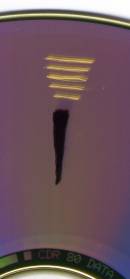
and the other is an old CDR that turned nearly unreadable at the beginning and at the end
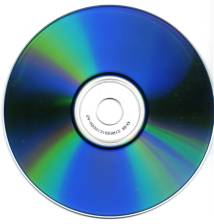
another good copy, showing no errors in secure mode, was used as a reference.
The black zone on the first CD emulates a burst error : a whole range of information is missing, while the rest is correct. The seconds CD features random errors : some data can be wrong anywhere.
The tests were started as soon as the DAEquality pack 1.2 was available, as a result, different versions of the analyse program were used.
Analyse version 1.2 : Counts errors in full ranges in
the log. Bug in digital silence handling, slight bug in
error count for the graphs.
Analyse version 1.3 : Counts errors in mono samples in
the log. First bug corrected.
Analyse version 1.4 : Second bug corrected.
Results
C2 accuracy
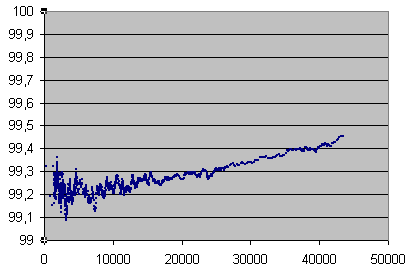
C2 accuracy
on random errors, in %, of the Memorex DVD Maxx 1648
firmware GWH2 DVD ROM drive, versus error rate in mono
samples
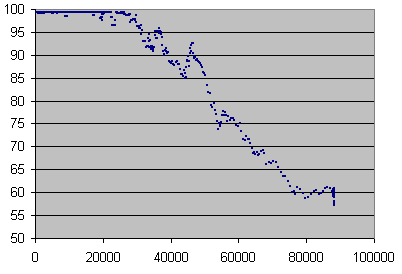
C2 accuracy
on random errors, in %, of the Sony
DDU1621 firmware S1.6 DVD ROM drive,
versus error rate in mono samples
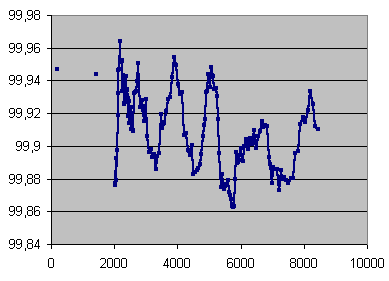
C2 accuracy
on random errors, in %, of the Teac
CD 540E firmware 1.0a and 3.0a CD ROM drive, versus error rate in mono
samples
Note that the Teac only reached 9184 errors per seconds with this test CD. In comparison, the Sony performed well in this range too, but completely collapsed past 20,000 errors per second. A harder test CD should be used with the Teac in order to check for accuracy at higher error rates.
C2 Error correction in CIRC
Facing a burst error, like a scratch, for example, simulated by a black mark painted on the CD.
| Drive | C2 error correction | Use of EFM to flag wrong bytes |
| Memorex DVD Maxx 1648 firmware GWH2 DVD ROM | up to 4 bytes | No |
| Teac CD 540E firmware 1.0a and 3.0a CD ROM | up to 4 bytes | Yes |
| Yamaha CRW3200EWK firmware 1.0d burner | up to 3 bytes | No |
| Sony DDU1621 DVD ROM firmware S1.6 | up to 4 bytes | No |
| Yamaha CDX860 CD Player | up to 2 bytes | Yes |
Error concealment
All drives were capable of performing linear
interpolation on isolated samples.
PC drives can't do better : if more than one isolated
sample is wrong, then they hold the last good value until
the last wrong sample, that is interpolated between the
hold value and the next sample.
The hifi player does better, it can perform a linear
interpolation over 8 consecutive bad samples. Beyond, it
holds the last valid sample, like PC drives.
The SPDIF output of the Memorex drive behaves exactly the
same as the digital audio extraction : no less error
correction, no more error concealment.
Complete results
DAEquality test CD results
Dead CDR results
Analysis
Error correction analysis (on request)
Appendix
1 : How to analyse the data returned by ANALYSE.EXE with Microsoft Exel.
2 : How to detect the internal audio error correction ability of a CD ROM drive
Pio2001, created in september 2002, last updated february the 6th, 2003
Contact :
![]()